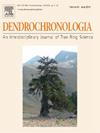Benchmarking Blue Intensity from drought limited Pinus sylvestris using tree-ring anatomy
IF 2.7
3区 农林科学
Q1 FORESTRY
引用次数: 0
Abstract
Robust, high-resolution proxy information on hydroclimate is critical for understanding the recent European drying in the context of natural variability. This is particularly true for Fennoscandia and the surrounding northern high latitude regions, where such records are scarce, and little is known about the physical drivers of these rare events. Recently, the potential of tree-ring Blue Intensity (BI) of Pinus sylvestris L. from cool drought-prone sites has emerged as a source of high-resolution hydroclimate information. Limitations to these proxies may however be linked to the analytical measurement resolution of the technique as well as potential color-related biases caused by the heartwood-sapwood transition and decay-associated discoloration of the tree-ring samples. These proxy uncertainties need to be addressed before the methodology can be used more systematically in the context of hydroclimate reconstructions. Here, we evaluate the reliability of BI tree-ring parameters, specifically regarding their ability to accurately track both low-frequency variations as well as hydroclimate extremes. This is accomplished by benchmarking these parameters against newly developed quantitative wood anatomical (QWA) data from Pinus sylvestris trees in southeast of Sweden. The ΔBI parameter shows a high similarity to its QWA analogue across scales ranging from interannual to centennial, suggesting that the Δ conversion efficiently overcomes the long-term trend biases seen in the raw BI data. The earlywood and latewood BI parameters record largely the same strong spring-summer precipitation signal, together explaining over 50 % of the variance in May-July precipitation, as do their QWA counterparts. However, both BI and QWA show a pronounced asymmetric response to precipitation extremes such that dry extremes are captured better than the wet extremes. This dry-biased extreme value capture needs careful consideration in future reconstruction efforts. We conclude that tree-ring BI holds significant potential for contributing to regional reconstructions, especially given the untapped opportunities to utilize the region’s extensive collection of historical pine material for paleoclimate research.
利用树木年轮解剖对干旱受限的西林松蓝强度进行基准测试
关于水文气候的可靠、高分辨率的代理信息对于理解在自然变率背景下最近欧洲的干燥至关重要。对于芬诺斯坎迪亚和周边的北部高纬度地区来说尤其如此,在那里这样的记录很少,而且人们对这些罕见事件的物理驱动因素知之甚少。近年来,来自寒冷干旱易发地区的西尔维斯松(Pinus sylvestris L.)树木年轮蓝色强度(BI)的潜力已成为高分辨率水文气候信息的来源。然而,这些代理的局限性可能与该技术的分析测量分辨率以及由心材-边材过渡和树木年轮样品的腐烂相关变色引起的潜在颜色相关偏差有关。在该方法能够更系统地用于水文气候重建之前,需要解决这些代理不确定性。在这里,我们评估了BI树轮参数的可靠性,特别是关于它们准确跟踪低频变化和极端水文气候的能力。这是通过将这些参数与瑞典东南部松树新开发的定量木材解剖(QWA)数据进行基准测试来完成的。ΔBI参数在从年际到百年的尺度上与QWA相似,表明Δ转换有效地克服了原始BI数据中出现的长期趋势偏差。早木和晚木BI参数记录了大致相同的强春夏降水信号,共同解释了5 - 7月降水变化的50% %以上,QWA的对应参数也是如此。然而,BI和QWA对降水极端值都表现出明显的不对称响应,因此干燥极端值比潮湿极端值更容易被捕获。在未来的重建工作中,需要仔细考虑这种干偏极值捕获。我们的结论是,树木年轮BI对区域重建具有重要的贡献潜力,特别是考虑到利用该地区广泛收集的历史松树材料进行古气候研究的未开发机会。
本文章由计算机程序翻译,如有差异,请以英文原文为准。
求助全文
约1分钟内获得全文
求助全文
来源期刊

Dendrochronologia
FORESTRY-GEOGRAPHY, PHYSICAL
CiteScore
5.50
自引率
13.30%
发文量
82
审稿时长
22.8 weeks
期刊介绍:
Dendrochronologia is a peer-reviewed international scholarly journal that presents high-quality research related to growth rings of woody plants, i.e., trees and shrubs, and the application of tree-ring studies.
The areas covered by the journal include, but are not limited to:
Archaeology
Botany
Climatology
Ecology
Forestry
Geology
Hydrology
Original research articles, reviews, communications, technical notes and personal notes are considered for publication.
 求助内容:
求助内容: 应助结果提醒方式:
应助结果提醒方式:


